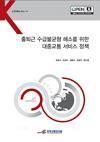Basic Report

RESEARCH
KOTI - Korea Transport institute
Public Transportation Policies on Commuter Balance and Efficiency
- Date
December 31 2014
- Page(s)
page(s)

The Sewol ferry cruise tragedy can probably be considered the worst transportation disaster in our country this past year of 2014. The Sewol ferry cruise disaster has led to a more thorough investigation concerning the safety and security of all aspects of our country's transportation system, especially in the area of metropolitan inter-city buses that link major areas of Seoul with outer metropolitan satellite cities. Inter-city buses utilize major highways and the law requires that major highway transit passengers to use a seatbelt; but there are too many passengers that ride standing up which poses great risks to their safety and can bring about dangerous consequences in the face of an accident if it were to occur.
The Ministry of Land, Infrastructure and Transportation, therefore, has been seeking an alternative way of arranging seats on the inter-city buses. Enhancing the size and appearance of the bus vehicle sounds like it may solve the problem; however, it adds to more congestion on the roads and increases travel time. Since enhanced bus vehicle cannot be operated during the non-peak hours of the day time, as transportation budget is low - without a bus fare hike, it would be difficult to operate. Thus, it is more complicated than have thought to solve this problem when considering all aspects of the spectrum.
This research seeks ways to resolve this transit problem on metropolitan intercity buses.
Shortening bus route's distance shortens travel time and increases dispatcher efficiency without the need to enhance the appearance of the bus vehicle. It may cause more discomfort in a rider's perspective; but it lowers the risk and dangers associated with getting into an accident; and moreover, additional passengers do not need to ride standing on the bus. This study has conducted theoretically possible methods for shorter bus travel distances that analyzes the user passenger behavior in 8 appropriate transfer points in 10 destinations of 7 trunk line of metropolitan areas. The 8 selected transfer points will be a crucial element of within the public transportation network. This research details out an in-depth analysis and action plan on installation of transit centers for these selected transfer points. This research will set a foundation for improving the public transport system
The Ministry of Land, Infrastructure and Transportation, therefore, has been seeking an alternative way of arranging seats on the inter-city buses. Enhancing the size and appearance of the bus vehicle sounds like it may solve the problem; however, it adds to more congestion on the roads and increases travel time. Since enhanced bus vehicle cannot be operated during the non-peak hours of the day time, as transportation budget is low - without a bus fare hike, it would be difficult to operate. Thus, it is more complicated than have thought to solve this problem when considering all aspects of the spectrum.
This research seeks ways to resolve this transit problem on metropolitan intercity buses.
Shortening bus route's distance shortens travel time and increases dispatcher efficiency without the need to enhance the appearance of the bus vehicle. It may cause more discomfort in a rider's perspective; but it lowers the risk and dangers associated with getting into an accident; and moreover, additional passengers do not need to ride standing on the bus. This study has conducted theoretically possible methods for shorter bus travel distances that analyzes the user passenger behavior in 8 appropriate transfer points in 10 destinations of 7 trunk line of metropolitan areas. The 8 selected transfer points will be a crucial element of within the public transportation network. This research details out an in-depth analysis and action plan on installation of transit centers for these selected transfer points. This research will set a foundation for improving the public transport system